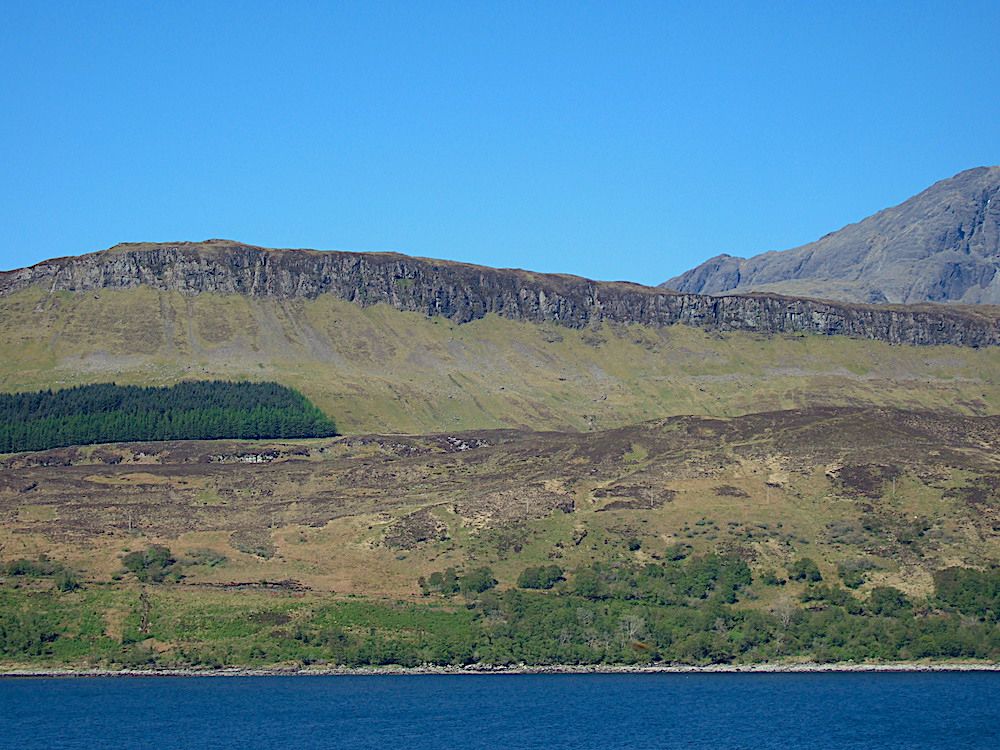The North Atlantic Igneous Province by Chris darmon and Colin Schofield
At the last meeting Chris Darmon and Colin Schofield gave a very informative talk on the North Atlantic Igneous Province (NAIP).
Chris explained that the NAIP is one of a number of what are known as Large Igneous Provinces ( LIP) which may be defined as “an intraplate magmatic event, with volumes of magma greater than 100,000 cubic kilometres". A couple of examples of other LIP’s are the Siberian Traps in Russia and the Deccan Traps in India. The NAIP is one of the larger LIP”s and is almost comparable with the Siberian Traps. It is centred on Iceland and occurs onshore in Greenland, the Faeroe Islands, the UK and Ireland and offshore surrounding these areas as well as the west coast of Norway.
Edge of a lava flow along the West coast of Skye.photo By Chris Simpson MWGC
The NAIP is made up of flood basalts,sills and dykes which were produced by intense igneous activity occurring during the Palaeocene and early Eocene. The cause of this activity being continental separation during the opening of the Atlantic Ocean. Isotopic dating has been undertaken which indicates that the most active magmatic phase of the NAIP was between ca.60.5 and ca. 54.5 Ma (mid-Palaeocene to early Eocene). The volcanism lasted for about 11 million years although each individual eruption was for a much shorter duration of about 2-3 million years.
The edge of a lava flow in NE Skye.There has been a landslip with separation of the areas of rock at the right of the photo from the rest of the lava flow. Note how these separate areas have rotated anti-clockwise as they slipped down slope. The orientation of the successive flows is clearly dipping West compared to the roughly horizontal direction of the main flows on the left of the photo photo by Chris Simpson MWGC
The cause of this continental breakup and volcanism has been explained by the presence of a mantle plume which today is centred under Iceland but there is a lot of controversy in this area and other models have been suggested. There is a lot of ongoing research into this area so that a complete model should eventually be found.
The bulk of the talk actually centred on the British portion of the NAIP which is known as the British Palaeogene Igneous Province (BPIP). The area covered by the BPIP include the Isles of Skye; Rum, Mull; Eigg and Arran, the Ardnamurchan peninsula, outer Hebrides along with Lundy off the coast of Wales and the Mourne Mountains in Northern Ireland.
Prior to the opening of the Atlantic NW Scotland was joined to Greenland and the Canadian Shield but as the Atlantic opened NW Europe moved away from North America and this separation continues to the present day due to sea-floor spreading along the mid-Atlantic Ridge.
Kilt Rock - a sill displaying well-developed columns photo by Chris Simpson MWGC
As North America and Europe moved apart huge volumes of basaltic lava erupted from long narrow fissures on what is now the west coast of Scotland. In addition there were extensive dyke swarms extending to the Outer Hebrides, southern Scotland, north Yorkshire and parts of north Wales. There were intrusions of granite, gabbro, peridotite and other rock types. The basaltic lavas produced the stepped or “trap” landscape that may be seen on Skye. Lavas also produced the Giant’s Causway in Northern Ireland and Fingal’s cave on the Isle of Staffa.Gabbro and peridotite have given rise to the rugged mountain scenery of St Kilda,Skye (Cuillins) and Rhum. The less rugged, mountains of northern Arran and the Skye Red Hills are composed of granite.
The Black Cuillins. This photo comes from about two-thirds of the way up. In the background are the tops of the Cuillins, black in colour and jagged in outline. In the foreground is smooth rock due to glaciation. It shows how high the glaciation came. Photo by Chris Simpson MWGC
Finally Chris highlighted the idea that the Palaeocene- Eocene Thermal Maximum (PETM), an event where there was a global increase of temperature between 5-8C can be linked to the NAIP producing changes in the earth’s carbon cycle and the increase in temperature. Work is still ongoing in this area.
In all a very instructive talk.
I



